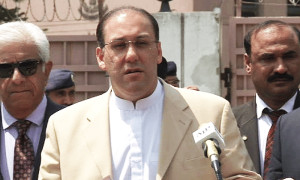RiazHaq
Senator (1k+ posts)
http://www.riazhaq.com/2018/02/how-can-pakistan-reduce-high-rates-of.html
Of every 1,000 babies born in Pakistan, 45.6 die before the end of their first month – 1 in 22, the highest infant mortality rate in the world, according to a United Nations Children's Fund report titled "Every Child Alive: The urgent need to end newborn deaths". Pakistan’s newborn mortality rate has declined by less than one quarter, from 60 in 2000 to 46 in 2016, according to UNICEF.
[TABLE="class: tr-caption-container, align: center"]
[TR]
[TD] [/TD]
[/TD]
[/TR]
[TR]
[TD="class: tr-caption"]Highest Contributors to Newborn Deaths Source: UNICEF[/TD]
[/TR]
[/TABLE]
Worst Countries:
Of the 2.6 million newborn dying each year worldwide, India tops with 24% share followed by Pakistan with 10%. Ten countries, Bangladesh, Ethiopia, Guinea-Bissau, India, Indonesia, Malawi, Mali, Nigeria, Pakistan and Tanzania account for more than half of the world’s newborn death, according to the report. Four of these 10 countries are in South Asia while the rest are in sub-Saharan Africa.
The percentage of mothers in Pakistan who gave birth in a health facility increased from 21 per cent to 48 per cent between 2001 and 2013, and the proportion of women giving birth with a skilled attendant more than doubled, from 23 per cent to 55 per cent over the same period. But despite these remarkable increases, largely the result of rapid urbanization and the proliferation of private sector providers not subject to satisfactory oversight, Pakistan’s very high newborn mortality rate fell by less than one quarter, from 60 in 2000 to 46 in 2016, according to UNICEF.
The report says that more than 80 per cent of newborn deaths can be prevented "with access to well-trained midwives, along with proven solutions like clean water, disinfectants, breastfeeding within the first hour, skin-to-skin contact and good nutrition."
Community-Based Health Care:
How can Pakistan increase the number of childbirths in the presence of skilled attendants? The best option appears to be a skilled midwives program along the lines of the Lady Health Workers (LHW) program that is considered effective in delivering health education and care to women in remote villages.
“It (LHW) is one of the best community-based health systems in the world,” said Dr. Donald Thea, a Boston University researcher, talking about Pakistan's Lady Health Workers Program. Thea is one of the authors of a recent Lancet study on child pneumonia treatment in Pakistan. He talked with the New York Times about the study.
Published in British medical journal "The Lancet", the study followed 1,857 children who were treated at home with oral amoxicillin for five days and 1,354 children in a control group who were given standard care: one dose of oral cotrimoxazole and instructions to go to the nearest hospital or clinic. The home-treated group had only a 9 percent treatment-failure rate, while the control group children failed to improve 18 percent of the time.
Community Midwives:
In response to the low levels of skilled birth attendance in rural Pakistan, the government has introduced a new cadre of community midwives (CMWs).
In 2008, Pakistan extended community-based health system with the introduction of an 18-month training program for community midwives. Then, in 2014, United Nations Population Fund – together with the Department of Health and Sindh Province’s Maternal, Newborn and Child Health program – launched a pilot effort to supplement the midwifery courses with hands-on training. Midwifery coaches visited the midwives’ clinics, offering guidance and mentorship, according to UNFPA. So far, over 300 midwives have benefitted from the coaching and mentorship program.
The Sindh UNFPA model needs to be scaled up across the country with the help of the federal and provincial governments in Pakistan.
Summary:
Pakistan is the riskiest country for newborns. Of every 1,000 babies born in Pakistan, 45.6 die before the end of their first month – 1 in 22, the highest infant mortality rate in the world, according to a United Nations Children's Fund report titled "Every Child Alive: The urgent need to end newborn deaths". Pakistan’s newborn mortality rate has declined by less than one quarter, from 60 in 2000 to 46 in 2016, according to UNICEF. The country's progress in reducing infant mortality rates has been very slow. There is an urgent need to improve the situation by by scaling up community-based midwife programs nation-wide.
http://www.riazhaq.com/2018/02/how-can-pakistan-reduce-high-rates-of.html
Of every 1,000 babies born in Pakistan, 45.6 die before the end of their first month – 1 in 22, the highest infant mortality rate in the world, according to a United Nations Children's Fund report titled "Every Child Alive: The urgent need to end newborn deaths". Pakistan’s newborn mortality rate has declined by less than one quarter, from 60 in 2000 to 46 in 2016, according to UNICEF.
[TABLE="class: tr-caption-container, align: center"]
[TR]
[TD]
 [/TD]
[/TD][/TR]
[TR]
[TD="class: tr-caption"]Highest Contributors to Newborn Deaths Source: UNICEF[/TD]
[/TR]
[/TABLE]
Worst Countries:
Of the 2.6 million newborn dying each year worldwide, India tops with 24% share followed by Pakistan with 10%. Ten countries, Bangladesh, Ethiopia, Guinea-Bissau, India, Indonesia, Malawi, Mali, Nigeria, Pakistan and Tanzania account for more than half of the world’s newborn death, according to the report. Four of these 10 countries are in South Asia while the rest are in sub-Saharan Africa.
The percentage of mothers in Pakistan who gave birth in a health facility increased from 21 per cent to 48 per cent between 2001 and 2013, and the proportion of women giving birth with a skilled attendant more than doubled, from 23 per cent to 55 per cent over the same period. But despite these remarkable increases, largely the result of rapid urbanization and the proliferation of private sector providers not subject to satisfactory oversight, Pakistan’s very high newborn mortality rate fell by less than one quarter, from 60 in 2000 to 46 in 2016, according to UNICEF.
The report says that more than 80 per cent of newborn deaths can be prevented "with access to well-trained midwives, along with proven solutions like clean water, disinfectants, breastfeeding within the first hour, skin-to-skin contact and good nutrition."
Community-Based Health Care:
How can Pakistan increase the number of childbirths in the presence of skilled attendants? The best option appears to be a skilled midwives program along the lines of the Lady Health Workers (LHW) program that is considered effective in delivering health education and care to women in remote villages.
“It (LHW) is one of the best community-based health systems in the world,” said Dr. Donald Thea, a Boston University researcher, talking about Pakistan's Lady Health Workers Program. Thea is one of the authors of a recent Lancet study on child pneumonia treatment in Pakistan. He talked with the New York Times about the study.
Published in British medical journal "The Lancet", the study followed 1,857 children who were treated at home with oral amoxicillin for five days and 1,354 children in a control group who were given standard care: one dose of oral cotrimoxazole and instructions to go to the nearest hospital or clinic. The home-treated group had only a 9 percent treatment-failure rate, while the control group children failed to improve 18 percent of the time.
Community Midwives:
In response to the low levels of skilled birth attendance in rural Pakistan, the government has introduced a new cadre of community midwives (CMWs).
In 2008, Pakistan extended community-based health system with the introduction of an 18-month training program for community midwives. Then, in 2014, United Nations Population Fund – together with the Department of Health and Sindh Province’s Maternal, Newborn and Child Health program – launched a pilot effort to supplement the midwifery courses with hands-on training. Midwifery coaches visited the midwives’ clinics, offering guidance and mentorship, according to UNFPA. So far, over 300 midwives have benefitted from the coaching and mentorship program.
The Sindh UNFPA model needs to be scaled up across the country with the help of the federal and provincial governments in Pakistan.
Summary:
Pakistan is the riskiest country for newborns. Of every 1,000 babies born in Pakistan, 45.6 die before the end of their first month – 1 in 22, the highest infant mortality rate in the world, according to a United Nations Children's Fund report titled "Every Child Alive: The urgent need to end newborn deaths". Pakistan’s newborn mortality rate has declined by less than one quarter, from 60 in 2000 to 46 in 2016, according to UNICEF. The country's progress in reducing infant mortality rates has been very slow. There is an urgent need to improve the situation by by scaling up community-based midwife programs nation-wide.
http://www.riazhaq.com/2018/02/how-can-pakistan-reduce-high-rates-of.html





































